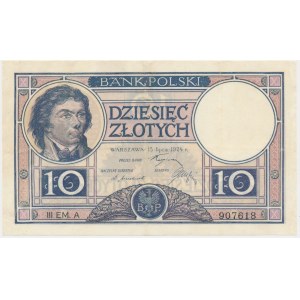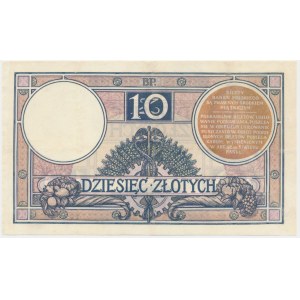Undoubtedly one of the rarest circulating Polish banknotes of the 20th century.
The 10 zloty 1924 of the third issue is a banknote that was not included in the first edition of Czesław Miłczak's catalog. Over the years, the authenticity of the variety was debated and questioned among enthusiasts. Some claimed that the banknote was a forgery based on a previous issue. The existence of designs marked with the third issue has definitely dispelled all doubts, and today it is an item sought after by advanced collectors, missing from the vast majority of Polish banknote collections.
The Lucow Collection's assigned rarity index of R8 is, in our opinion, awarded slightly overstated, although R7 reliably reflects the real rarity of the offered banknote. Known auction listings should close in on 10 pieces!
The offered piece has an album-like appearance, which is the result of conservation carried out with great sensitivity.
The paper, despite the restorer's reinforcement on the fracture lines, retains the paper's natural texture on large sections, and the printing colors are only immaculately lightened. The paper rustles and is clean, naturally as a result of skillful cleaning.
One of the rarest 20th century banknotes, a beautiful item, a first-class value that is missing from many advanced collections.
In 1919, a law was passed to name the future Polish currency and to establish the Bank of Poland. It was thought that it would be possible to carry out the exchange of Polish marks for zlotys in a short time. The only reason, as it seemed at the time, for not implementing the resolution was the lack of means of payment bearing value in the new currency. The difficult situation of the reborn country influenced the fact that it was decided to introduce only banknotes into circulation. Due to the lack of a modern printing plant in the country, the order was turned to abroad. Because of the rush, the question of the appearance of the graphic design of Polish paper money was left in the hands of graphic designers employed by the printing houses that were to make the banknotes. The order was accompanied by photographs of popular images of Tadeusz Kosciuszko and Jozef Poniatowski.
Initially, ten denominations were planned for circulation. The lower denominations from 1 to 50 zlotys were printed in 1919 by the Banque de France. On the other hand, banknotes with denominations from 100 to 5,000 were printed in 1920 by the London printing house Waterlow & Sons Limited.
In 1924, Poland underwent a currency reform that resulted in the conversion of Polish marks into zlotys. On the day the Bank of Poland opened, six of the ten denominations were allowed into circulation. Banknotes in the denominations of 1 and 2 zlotys were put into circulation as pass tickets of the Ministry of the Treasury, but were not provided with the appropriate overprints informing of this fact. The two highest denominations - 1,000 and 5,000 zlotys - also did not enter circulation. These banknotes were not put into circulation because their face value was too high.
The graphic design of the banknotes ordered in 1919 is kept in a neo-Baroque style. Only the 10 zloty is characterized by Art Nouveau geometrization of space. Starting from the 50 zloty denomination, the graphic design of each denomination is enriched by ornamental motifs in the form of acanthus leaves, fruit bunches, shells, palmettes and guilloches.The main accent of the obverse of each denomination is a bust of a national hero. On the reverse of banknotes of 5, 20, 50, 100 and 500 zlotys at the height of the portrait of Kosciuszko or Poniatowski was placed a White Eagle in an open crown.In mid-1924, the money market experienced shortages of the most commonly used paper money in everyday life. In view of the situation, it was decided to print banknotes with denominations of 5, 10 and 20 zlotys. This task was entrusted to the State Graphic Works in Warsaw. On the banknotes printed in Warsaw, the date of issue was changed to July 15, 1924, the wording of the legal clause and the signatures.










